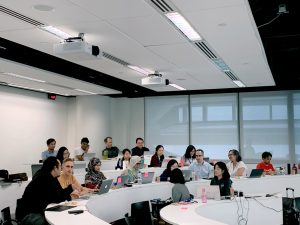Discover why dedicated IT solutions are essential for educational institutions to provide the best possible learning experience. Read on to learn how it can improve student engagement, streamline administration, and enhance learning outcomes.”
As technology continues to advance, its role in education is becoming increasingly important. Educational institutions need to embrace technology and leverage it to provide better learning outcomes. In this blog, we will explore the reasons why schools and universities need dedicated IT solutions.

Improved Student Engagement:
In today’s digital age, integrating the latest technology in educational institutions can significantly enhance student engagement and participation in the learning process. By leveraging hybrid learning programs like virtual reality (VR) technology, students can explore complex concepts in a more interactive and immersive manner. Research has shown that when students are actively engaged in their learning, they are more likely to retain information and develop a deeper understanding of the subject matter.
Hybrid learning programs combine traditional classroom instruction with online and digital resources. This approach allows students to access learning materials anytime and anywhere, providing flexibility and personalized learning experiences. Incorporating interactive multimedia content, such as videos, simulations, and virtual experiments, can capture students’ attention and make learning more enjoyable. Virtual reality technology takes this engagement to the next level by creating a virtual environment where students can interact with virtual objects and scenarios that simulate real-life situations. For example, students can virtually explore historical landmarks, travel through space, or dive into the depths of the ocean, all from the confines of the classroom.
Studies have demonstrated the positive impact of virtual reality on student engagement and learning outcomes. A research study conducted by Albrecht and Spector (2013) found that students who used virtual reality in their learning showed increased motivation, higher levels of concentration, and better retention of knowledge compared to traditional instructional methods. Innovative technologies like VR creates an immersive and experiential learning environment that sparks curiosity, encourages exploration, and fosters critical thinking skills.
Streamlined Administration:
Administrative tasks in educational institutions can be time-consuming and resource-intensive. However, with the implementation of a dedicated IT solution, these processes can be streamlined and made more efficient. Automation plays a key role in reducing the burden of administrative tasks, allowing teachers and staff to focus on what matters most: providing quality education and support to students.
An IT solution can automate various administrative functions such as attendance tracking, grading, and student record-keeping. For example, sophisticated software systems can automatically track student attendance using biometric identification or RFID technology, eliminating the need for manual attendance taking. Grading and assessment processes can also be automated, saving teachers valuable time and ensuring accuracy and consistency in evaluations.
Furthermore, student record-keeping can be digitized and stored in a centralized database, enabling easy access and retrieval of student information. This eliminates the need for physical paper records, reduces the risk of data loss or misplacement, and enhances data security and privacy.
Streamlining administrative processes not only saves time and resources but also enhances overall operational efficiency. By automating routine tasks, educational institutions can allocate more time and resources towards instructional activities, professional development, and student support services. Ultimately, this leads to improved productivity, better resource utilization, and a more positive learning environment for students.
Enhanced Learning Outcomes:
Tailoring the learning experience to meet the unique needs of each student is a critical aspect of education. With a well-designed IT solution, educators can personalize the learning process, track student progress, and provide targeted support, leading to enhanced learning outcomes.
One essential tool in achieving this is a learning management system (LMS). An LMS serves as a comprehensive platform where educators can create, deliver, and manage educational content. It enables teachers to develop customized learning plans that cater to individual student strengths, weaknesses, and learning preferences. By offering a variety of learning materials, including videos, interactive modules, and online quizzes, an LMS provides students with a flexible and adaptive learning experience.
The use of an LMS also facilitates tracking and monitoring of student progress. Educators can assess student performance through online assessments and quizzes, and the system generates detailed reports on individual and class-wide performance. This data helps identify areas where students may need additional support or intervention. Moreover, educators can provide timely feedback and guidance to students, promoting continuous improvement and personalized instruction.
Research studies have consistently shown the positive impact of personalized learning and the use of learning management systems on student achievement. For example, a study conducted by Means & Murphy (2013) found that students who used an LMS to access personalized learning materials and receive feedback from teachers showed significant gains in their academic performance compared to students in traditional classrooms.
Additionally, technology-enabled learning environments offer various tools and resources to cater to diverse learning styles and abilities. For instance, adaptive learning software can dynamically adjust the difficulty and pace of learning activities based on each student’s progress and performance. This adaptive approach ensures that students are appropriately challenged and supported, leading to greater engagement and improved learning outcomes.
Moreover, the integration of multimedia elements, interactive simulations, and gamification techniques within the IT solution can further enhance student motivation and learning. Studies have shown that gamified learning experiences, where students earn points, badges, or compete in virtual challenges, can increase student engagement and persistence in learning activities (Hamari & Sarsa 2016).
It is worth noting that technology alone does not guarantee enhanced learning outcomes. Effective implementation and proper training for educators are crucial to harnessing the full potential of IT solutions in education. Ongoing professional development programs that focus on integrating technology into instructional practices and promoting effective pedagogical strategies are essential for educators to leverage technology effectively and maximize its impact on student learning.

We are offering a “free 10-point IT assessment” for your organisation along with a detailed report of our findings and recommendations.
In conclusion, investing in a well-designed IT solution can significantly contribute to improved student engagement, streamlined administration, and enhanced learning outcomes in educational institutions. The integration of the latest technology, personalized learning experiences, and effective use of learning management systems empower educators to create a dynamic and adaptive learning environment. By embracing these advancements, educational institutions can better prepare students for the challenges of the digital age and equip them with the necessary skills and knowledge for future success.
References:
- Albrecht, R., & Spector, J. M. (2013). Introduction to virtual reality in education. In J. M. Spector, M. D. Merrill, J. Elen, & M. J. Bishop (Eds.), Handbook of research on educational communications and technology (pp. 735-745). Springer.
- Hamari, J., Koivisto, J., & Sarsa, H. (2016). Does gamification work? A literature review of empirical studies on gamification. In Proceedings of the 49th Hawaii International Conference on System Sciences (HICSS) (pp. 3025-3034). IEEE.
- Means, B., Bakia, M., & Murphy, R. (2013). Learning online: What research tells us about whether, when, and how. Routledge.




